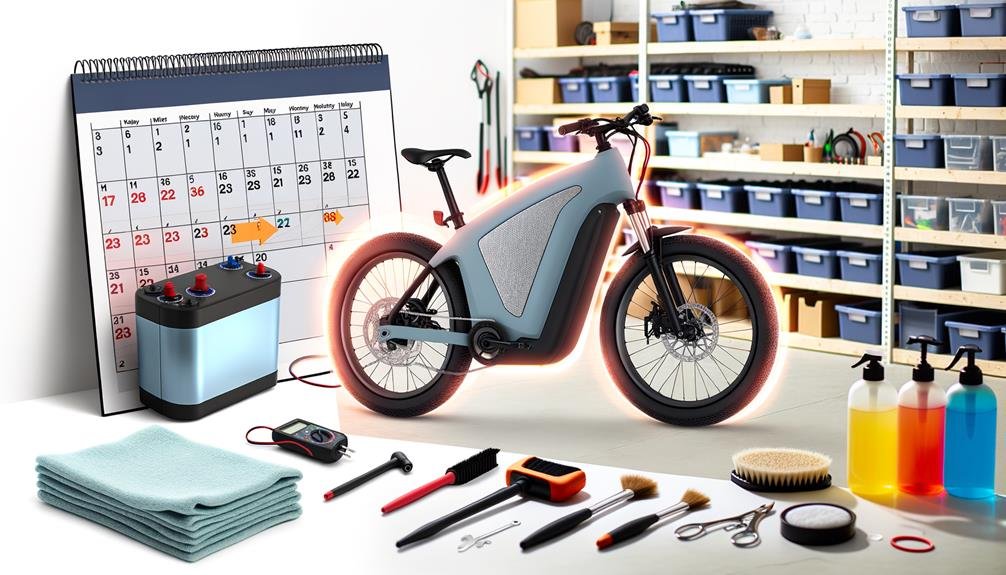Charles Miller is a veteran bike enthusiast with over 12 years of experience dealing with bikes as a mechanic. Despite immense love and expertise for...
The lifespan of electric bike batteries is a fundamental subject for individuals investing in e-bikes, as it significantly contributes to the overall performance and cost-efficiency of the vehicle. While it's generally understood that these batteries can last between 3-5 years, or even up to 8 years under ideal circumstances, a multitude of factors such as the frequency of use, charging practices, and storage conditions influence their actual longevity.
Consequently, understanding these factors and their impact is crucial for optimizing the lifespan of your e-bike battery, presenting a compelling reason to further explore this topic.
Key Takeaways
- Regular use and frequent discharge-recharge cycles contribute to battery degradation.
- Extreme temperatures, both hot and cold, diminish battery lifespan.
- Proper maintenance, such as maintaining a charge of 20-80% and using the original charger, prolongs battery life.
- Storing the battery at room temperature and avoiding extreme temperatures is crucial for battery longevity.
Understanding E-bike Battery Lifespan
The lifespan of an electric bike battery, a crucial component dictating the performance and longevity of the e-bike, typically ranges from 3 to 5 years due to gradual capacity decline, although in perfect conditions, it can last up to 8 years. This understanding of e-bike battery lifespan is essential for proper care and maintenance, ensuring that your eBike battery lasts its full potential.
Factors such as charge-drainage-recharge cycles, regular use, and environmental conditions all contribute to battery degradation. Blix batteries, for instance, have a lifetime of 25,000 miles, or between 500-800 charging cycles. However, lithium batteries degrade over time, even when not in use.
Moreover, the weather conditions in which the electric bike is stored and used can significantly impact the battery life. Cold weather temporarily reduces battery capacity, while high temperatures can diminish its lifetime. Therefore, storing the battery at room temperature (50-77℉) is recommended.
To further optimize battery lifetime, maintain a charge of 20-80%, avoid leaving the battery fully uncharged for extended periods, and use the Blix charger provided with the eBike for optimal performance.
Factors Affecting Battery Longevity
What are the key factors that significantly affect the longevity of an electric bike battery? Electric bike batteries, particularly lithium-ion batteries, are susceptible to several factors that can significantly impact their lifespan.
| Factors | Effect on Battery Longevity |
|---|---|
| Usage and Charge Cycle | Regular use and frequent discharge-recharge cycles contribute to battery degradation. |
| Temperature | Extreme temperatures, both hot and cold, diminish battery lifespan. |
| Maintenance | Proper maintenance, such as maintaining a charge of 20-80% and using the original charger, prolongs battery life. |
| Storage Conditions | Storing the battery at room temperature and avoiding extreme temperatures is crucial for battery longevity. |
| Charging Etiquette | Smart charging etiquette, such as avoiding frequent charging from empty to full, extends battery life. |
Understanding these factors affecting battery longevity is essential for anyone seeking to maximize the life of their e-bike's battery. Battery longevity is not just about the life of the battery, but also about maintaining the battery capacity to ensure efficient and sustained performance. By adhering to optimal practices, riders can significantly enhance the longevity of their electric bike batteries, enjoying longer rides and reducing the frequency and cost of battery replacements.
Common Battery Life Expectancy

The life expectancy of electric bike batteries is influenced by several factors, including how they are maintained and used. This section will present a comprehensive overview of these factors, as well as provide practical tips for battery maintenance and advice on battery replacement and disposal.
Factors Impacting Battery Longevity
Understanding the factors influencing the longevity of an electric bike's battery life—such as usage patterns, environmental conditions, and maintenance practices—is crucial for maximizing its lifespan.
Here are some factors impacting battery longevity:
- Usage patterns: Regular use leads to gradual capacity decline due to the charge-drainage-recharge cycles.
- Battery type: Lithium batteries degrade over time, impacting their longevity.
- Weather conditions: Extremes in temperature affect the battery's lifespan—heat leads to electrode breakdown while cold decreases capacity and can cause cathode fracture.
- Charge cycles: Maintaining a charge of 20-80% and using the original charger can help prolong battery life.
- Maintenance practices: Regular maintenance and proper storage are essential for extending the overall lifetime of electric bike batteries.
Maintaining Your E-Bike Battery
Having dissected the various factors impacting the lifespan of an e-bike battery, it is imperative to explore practical methods for maintaining these batteries, keeping in mind that under optimal circumstances, they can potentially last up to 8 years. High-quality maintenance is key in determining how long electric bike batteries last.
| Maintenance Steps | Frequency | Importance |
|---|---|---|
| Frequently charging | Monthly | Prevents capacity decline |
| Store at room temperature | Consistently | Avoids temperature-related issues |
| Maintain a charge of 20-80% | Always | Preserves longevity |
| Use the provided charger | Always | Ensures optimal charging |
| Avoid leaving battery fully uncharged | Always | Prevents damage |
Replacement and Disposal Tips
Navigating through the realm of e-bike battery life expectancy, which typically spans between 3 to 5 years, requires a comprehensive understanding of replacement and disposal practices to ensure optimal performance and environmental sustainability.
It is integral to ensure battery replacement when its performance drops below 56% of its original capacity.
Given the environmental impact, proper disposal of Ebike batteries is critical. Many retailers offer recycling programs.
It's essential to replace the battery with one of an equivalent or better quality to maintain your electric bike's performance.
Regular examination of the battery for any wear and tear, dust, or rust is vital in maintaining its longevity.
Proper storage of batteries in a cool, dry place prolongs their life expectancy and ensures optimal performance.
Optimizing Charging Practices

Optimizing charging practices is integral to extending the lifespan of electric bike batteries. It is essential to adopt correct charging techniques such as maintaining a charge of 20-80% and using the manufacturer-provided charger.
Furthermore, the charging environment and regular maintenance, even during periods of storage, significantly influence battery longevity.
Correct Charging Techniques
To ensure optimal battery lifetime and capacity for your electric bike, it is crucial to maintain a charge level between 20 and 80 percent and utilize the Blix charger that comes with the ebike. It is one of the most important correct charging techniques to remember after your ebike purchase.
The lifespan of the lithium battery, which is a significant factor in how long do electric bike batteries last, can be extended with these practices:
- Always use the Blix charger provided with your electric bicycle for optimal performance and safety.
- Charge in a well-ventilated, dry, indoor environment.
- Even during storage, charge your battery for two hours monthly.
- Avoid frequently charging from empty to full.
- Prevent overcharging to avoid unnecessary strain on the battery.
Prolonging Battery Lifespan
Extending the lifespan of your electric bike's battery involves implementing optimized charging practices that not only maintain but also improve the battery's health and longevity. By taking care of a quality battery, you can significantly answer the question of how long do electric bike batteries last.
The table below provides key practices for prolonging battery lifespan:
| Optimal Charging Practice | Description |
|---|---|
| Charge within 20-80% | This range maintains battery health |
| Avoid full discharge | Prevents damage and retains capacity |
| Use the provided charger | Ensures compatibility and safety |
| Regular charging | Even during storage, charge for two hours every month |
These practices coupled with consistent use of pedal assist can lead to a longer-lasting, more efficient electric bike battery.
Ideal Storage Conditions for Batteries
Proper storage of electric bike batteries is crucial for their longevity, and involves avoiding exposure to extreme temperatures, direct sunlight, and damp environments. This is especially true for lithium batteries, which are common in electric bikes. The way you store your ebike battery can significantly determine how long ebike batteries last.
Ideal storage conditions for batteries are pivotal to maintaining their lifespan. These conditions include:
- Keeping the battery in a shaded and sheltered area during hot weather: This helps avoid overheating which can result in reduced battery lifespan.
- Avoidance of direct sunlight and extreme cold temperatures: These conditions can cause a battery to underperform and deteriorate faster.
- Keeping the battery away from damp or wet environments: Moisture can corrode battery cells, causing them to fail prematurely.
- Storing the battery at room temperature (50-77℉): This is the optimal temperature range for battery storage.
- Keeping the battery away from heat sources: Excessive heat can cause the battery to swell, leak, or even explode.
Providing the ideal storage conditions for batteries is an integral part of keeping the battery in top condition, thereby ensuring a longer lifespan for your electric bike's power source.
Importance of Proper Battery Maintenance

Ensuring the longevity and optimal performance of electric bike batteries necessitates regular and meticulous maintenance practices. The importance of proper battery maintenance cannot be overstated. Good quality electric bikes come with reliable batteries, but common battery problems can be averted with due diligence in maintenance.
Adhering to recommended charging practices and using the original charger can significantly boost the battery's health. A battery maintained well can extend how long an eBike battery lasts, thereby maximizing your investment.
Below is a table summarizing some crucial battery maintenance practices:
| Maintenance Practice | Purpose | Impact |
|---|---|---|
| Regular Charging | Keeps the battery active | Enhances performance |
| Using Original Charger | Ensures appropriate charging rate | Prevents overcharging |
| Temperature Control | Avoids extreme temperatures | Prevents capacity loss |
| Avoiding Water Damage | Prevents short circuits | Ensures longer lifespan |
Storing the battery at room temperature, avoiding water damage, and following proper storage and charging recommendations can significantly enhance the battery's longevity. Remember, meticulous maintenance is not a choice but a necessity for every eBike owner desiring the best performance from their investment.
Tips for Extending Battery Life
Building on the importance of meticulous maintenance, let's explore specific strategies for prolonging electric bike battery life. These tips for getting the most out of your lithium-based battery can ensure a long, efficient lifespan, particularly if one avoids subjecting the battery to extreme heat or cold.
Here are five practical ways of extending battery life:
- Maintain Charge Level: Keeping your battery charge between 20-80% can optimize its lifespan. Full discharge or overcharging can degrade lithium batteries over time.
- Use Blix Charger: The charger provided with the ebike is designed for optimal performance. Utilizing it can optimize the battery's long-term health.
- Charge in Well-Ventilated, Dry Indoor Settings: Heat and moisture can damage lithium batteries. Charging in a cool, dry place can protect and prolong battery life.
- Charge Frequently: Charging the battery often, especially between rides, can improve battery health.
- Avoid Extreme Temperatures: Lithium batteries are sensitive to temperature. Storing the battery at room temperature and avoiding exposure to extreme heat or cold is crucial.
Frequently Asked Questions
How Many Hours Does an Electric Bike Battery Last?
The duration of an electric bike battery depends on battery type, maintenance, and charging techniques. Typically, they can last between 3 to 5 years with efficient use and proper care, enhancing overall battery lifespan.
How Much Does It Cost to Replace a Battery on an Electric Bike?
Replacement cost of electric bike batteries varies between $500 and $1000. Factors like battery maintenance costs, warranty considerations, upgrading batteries, and exploring second-hand batteries or battery recycling options can influence this expense.
When Should I Replace My Ebike Battery?
Ebike batteries should be replaced when their capacity significantly declines. Battery longevity factors, maintenance routines, and improving battery lifespan are crucial. Remember to follow proper battery disposal methods and check your battery warranty coverage.
How Far Can a Electric Bike Go on a Full Battery?
The distance an electric bike can cover on a full battery varies based on battery type, cycling conditions, and charging practices. With optimal battery maintenance, it could range from 20 to 50 miles per charge.
Conclusion
In conclusion, the lifespan of electric bike batteries is contingent upon various factors such as usage, temperature and charging practices.
Ironically, these batteries, designed to empower mobility, are themselves prisoners to specific conditions. It is imperative to adhere to optimal charging practices and storage conditions, as neglect can significantly shorten battery life.
Thus, conscientious battery maintenance is essential to ensure an extended and efficient battery life, thereby maximizing the potential of your electric bike.

Charles Miller is a veteran bike enthusiast with over 12 years of experience dealing with bikes as a mechanic. Despite immense love and expertise for his Tacoma, he rides his Trek Ebike more. Anytime you meet him, you’ll either hear him talking about Bikes, or writing about all things bikes and cars on this blog.
More Posts


